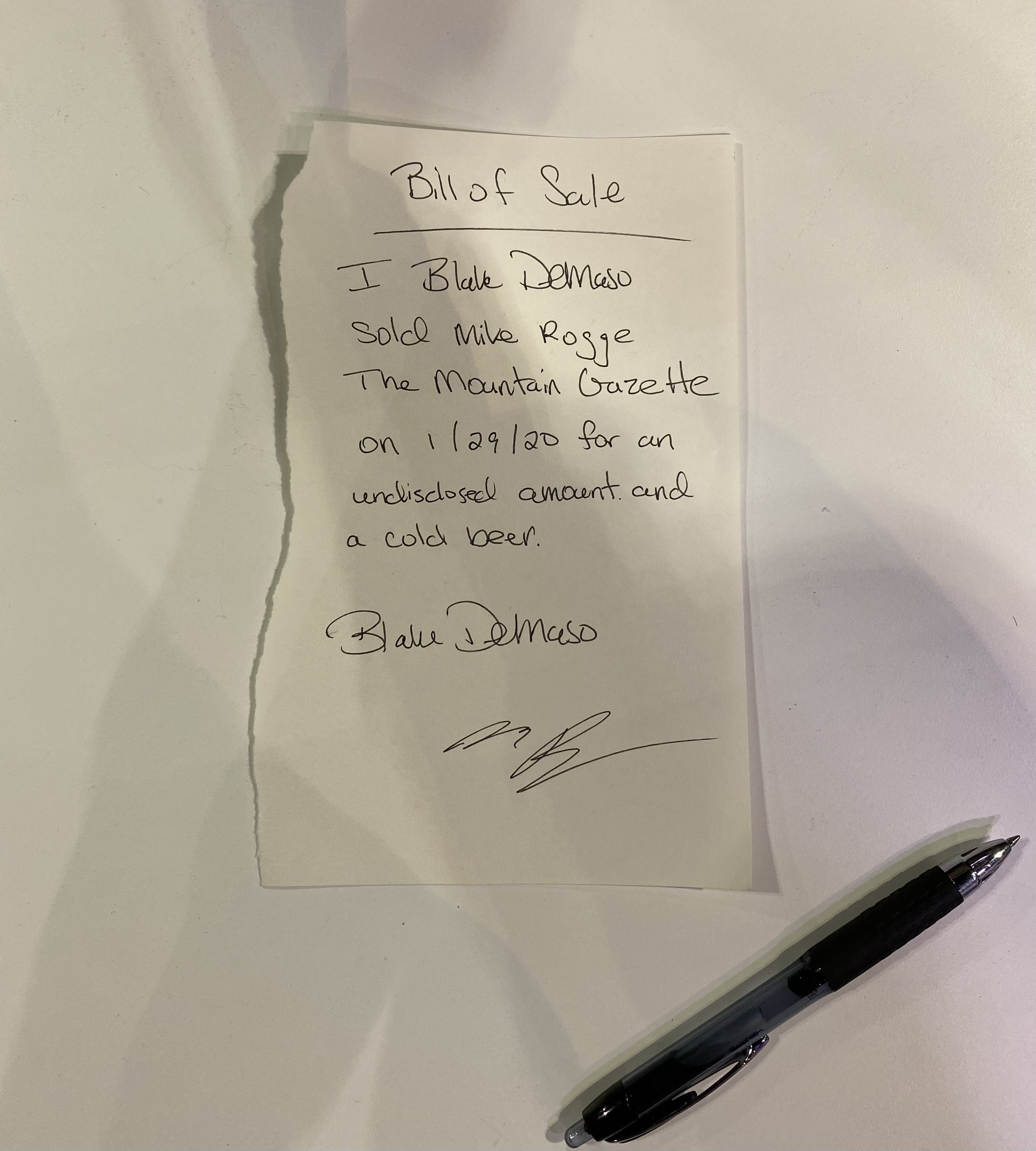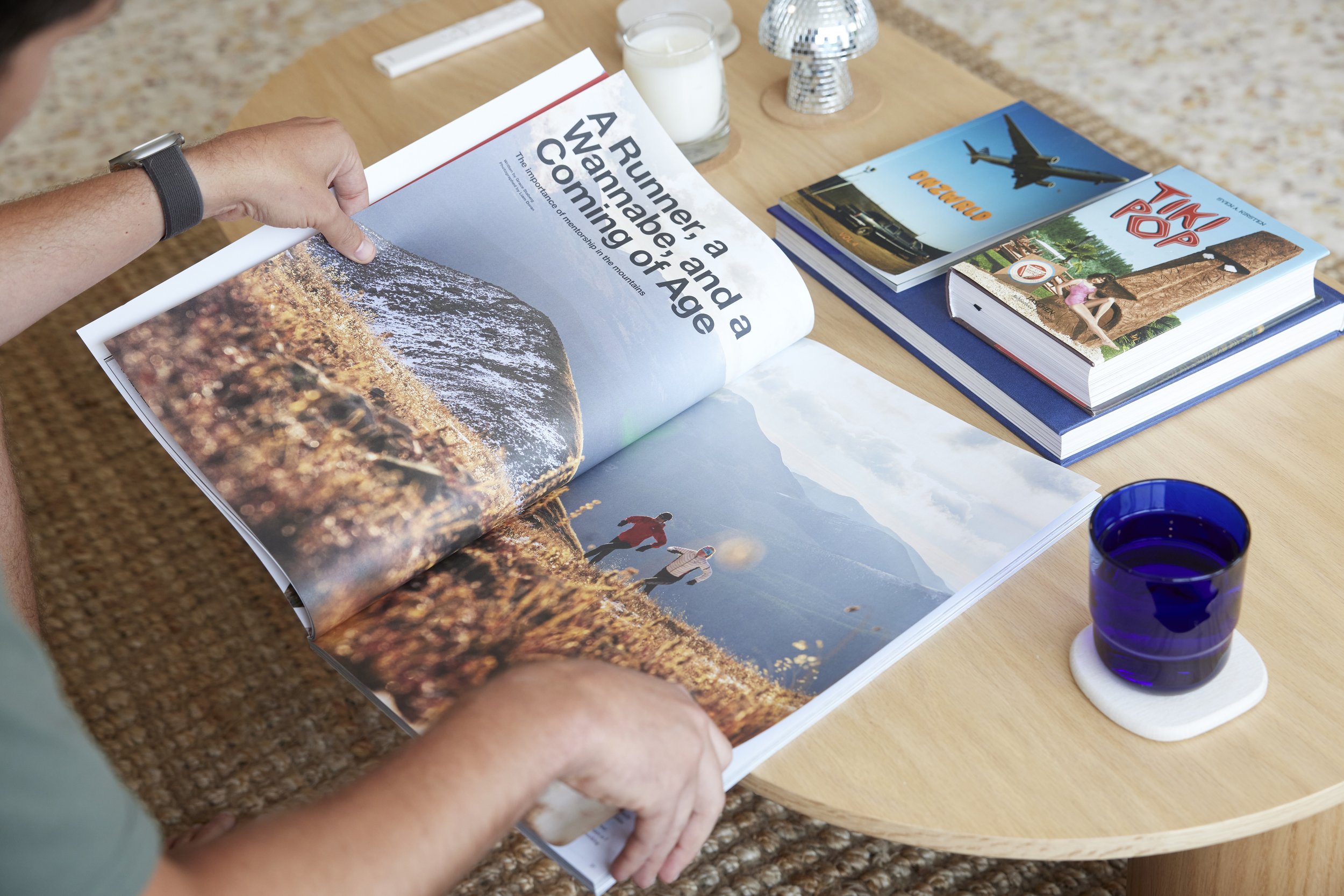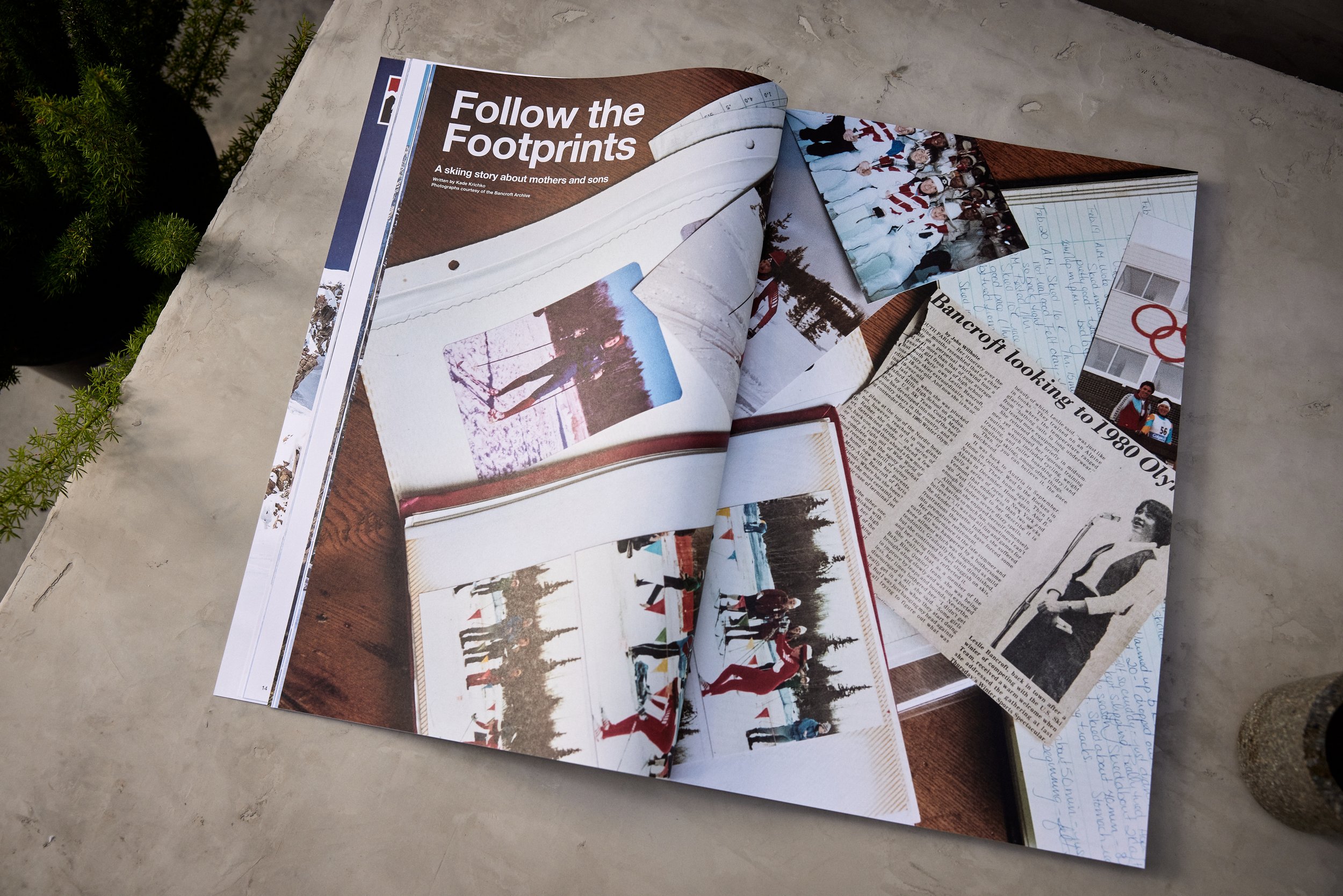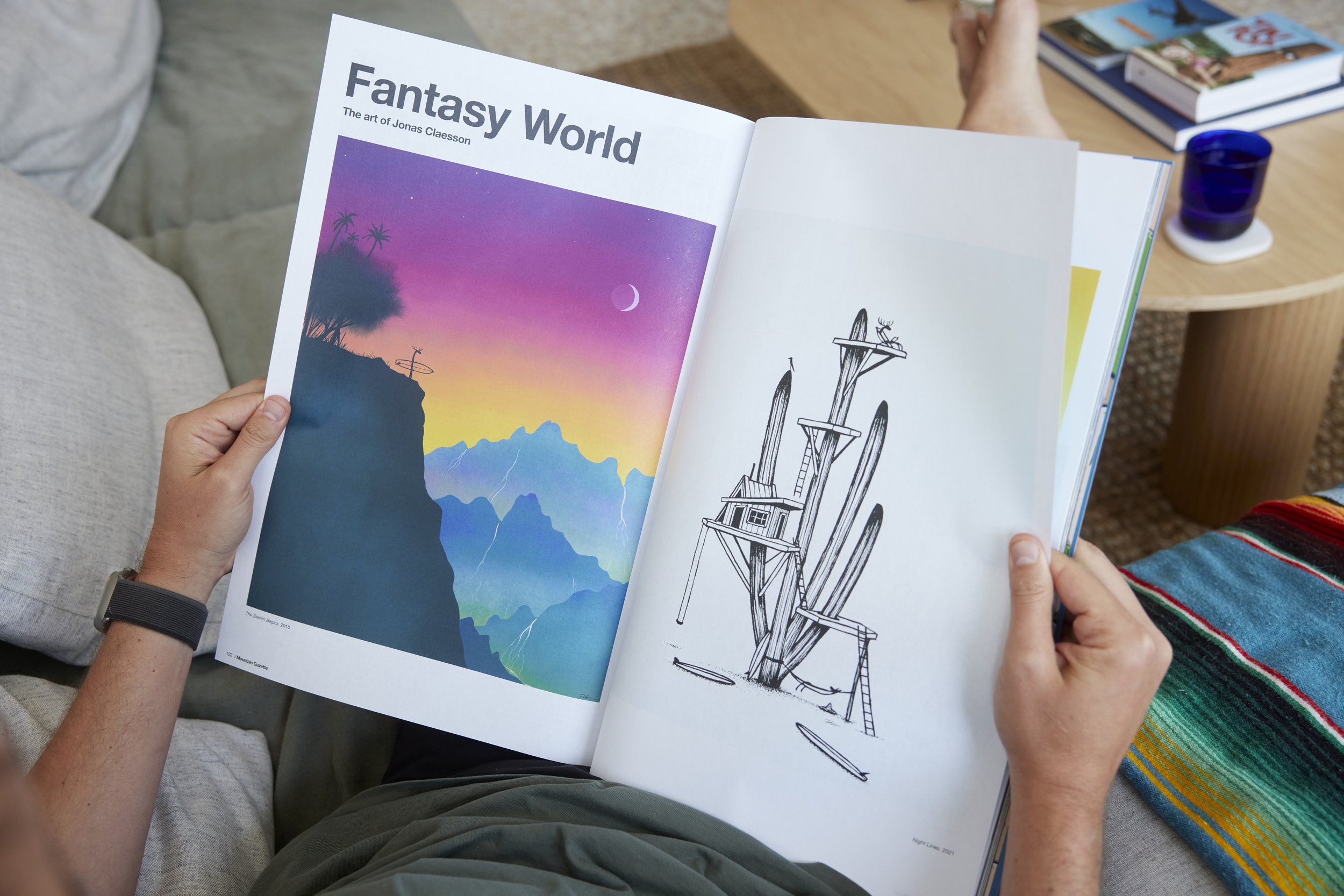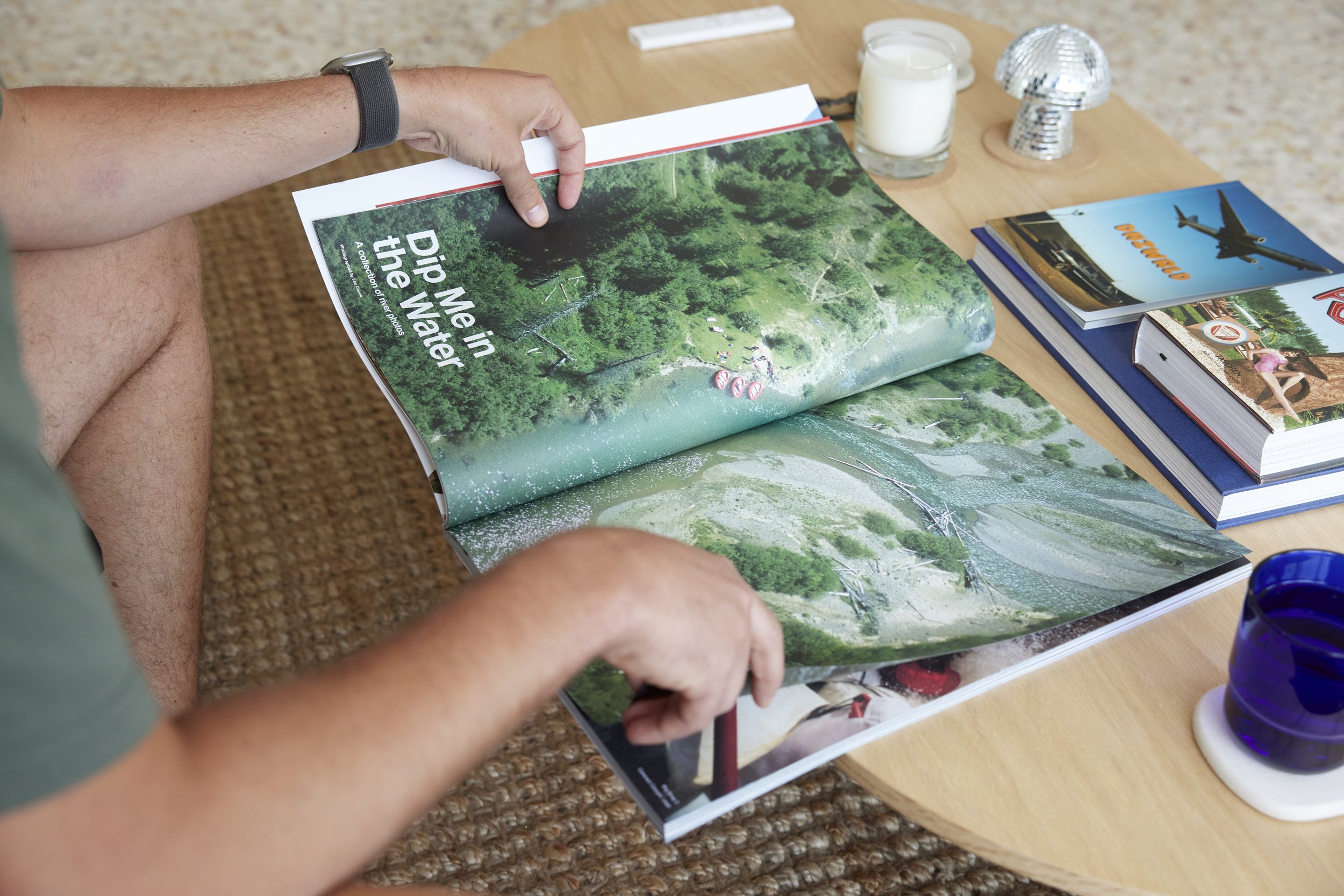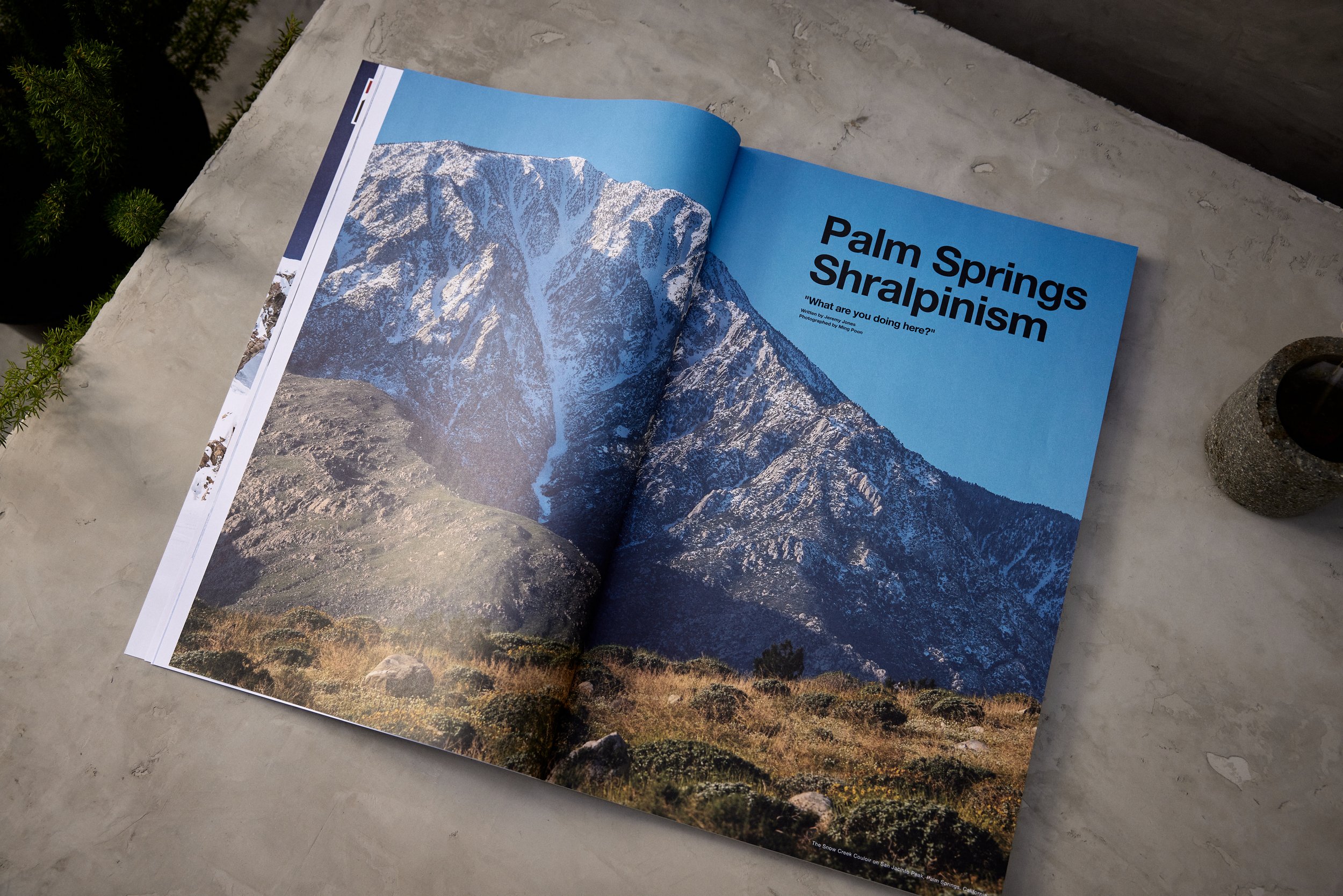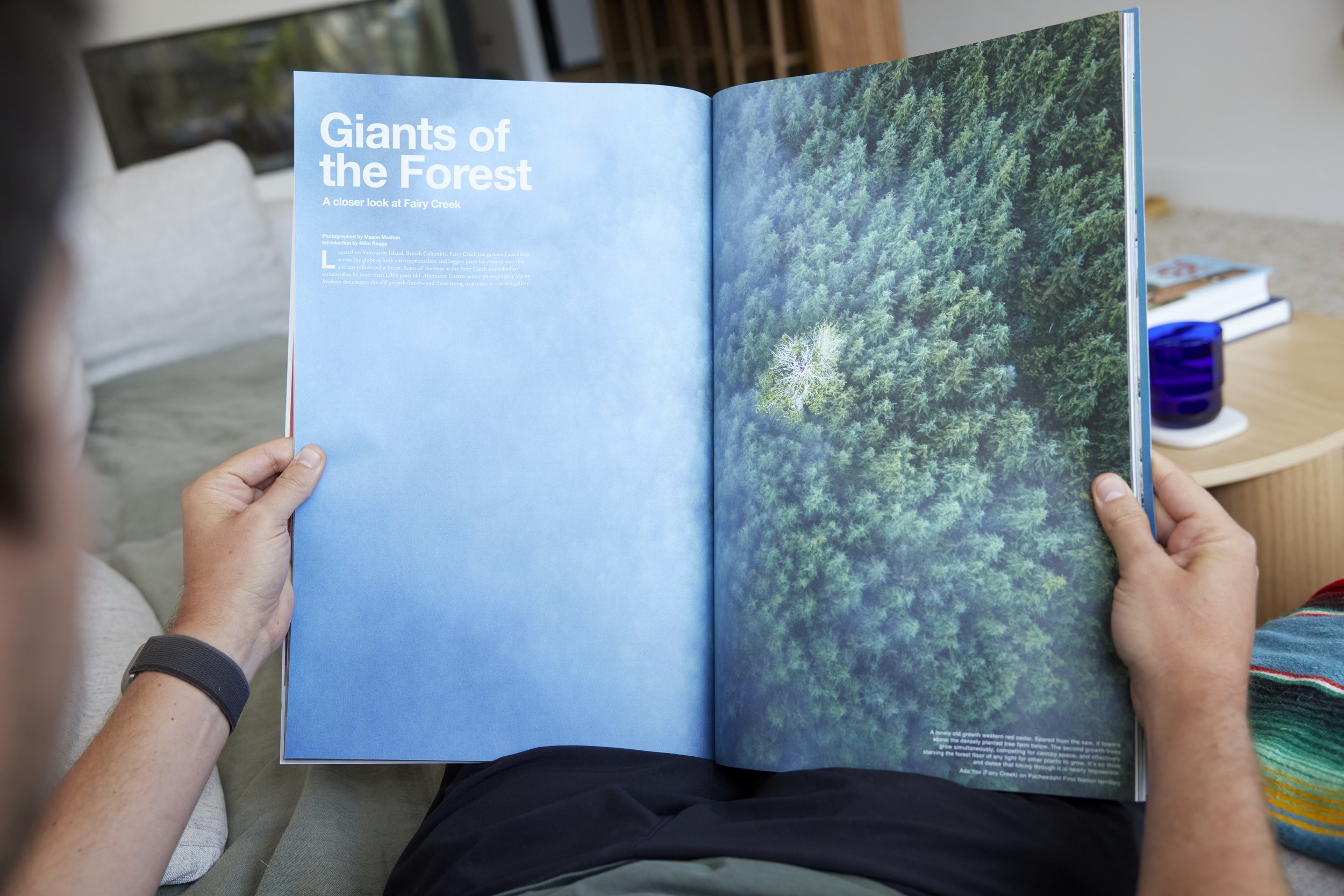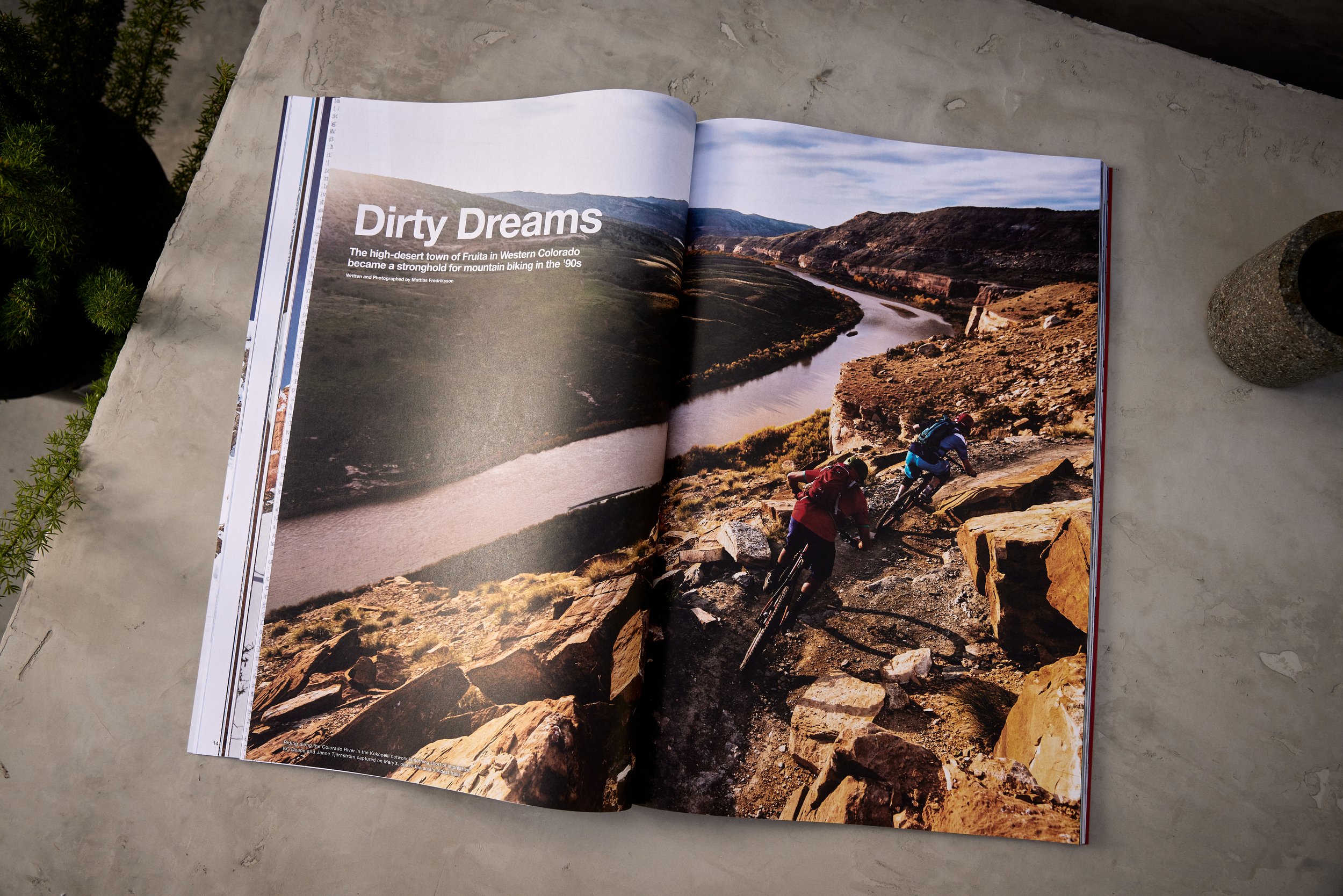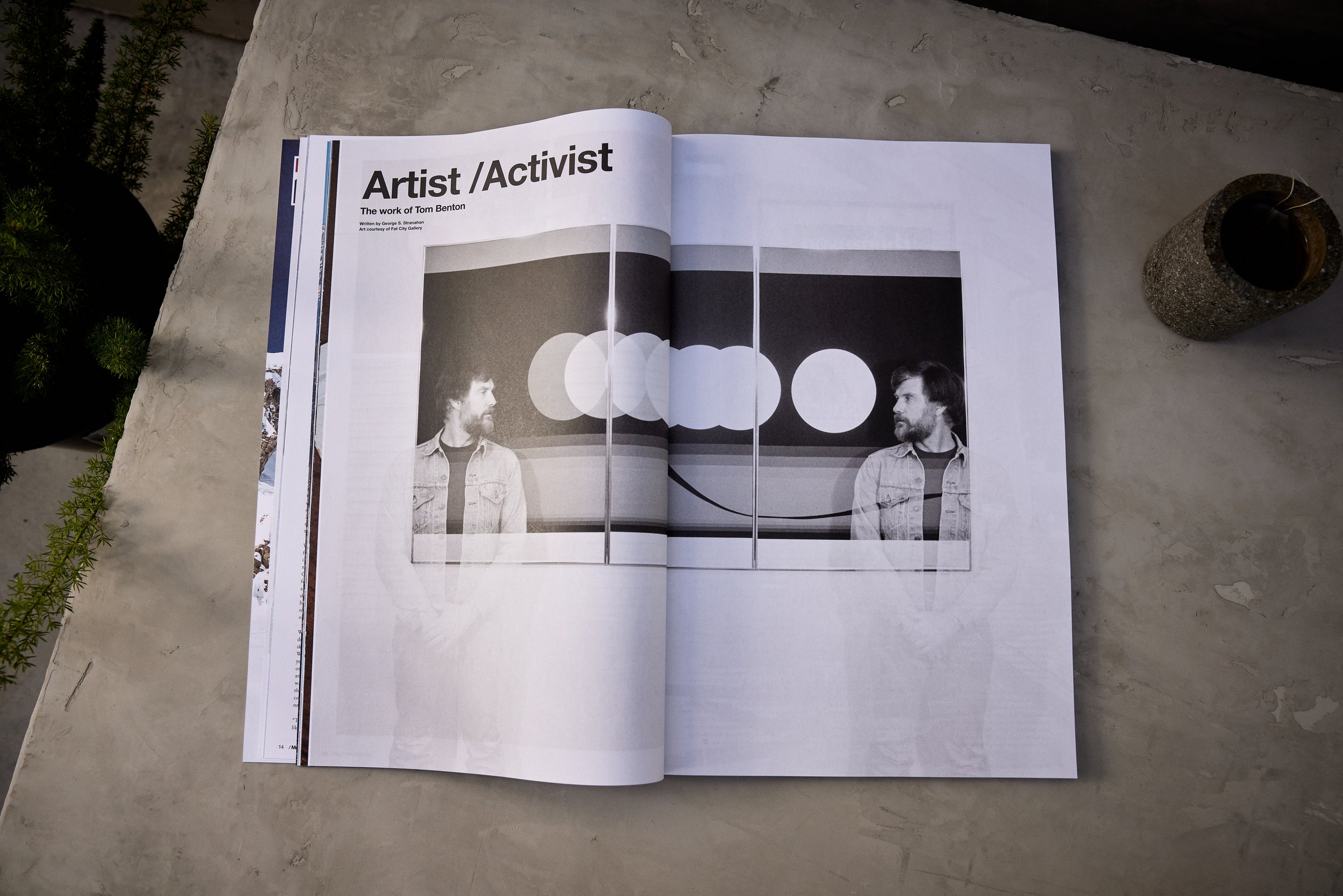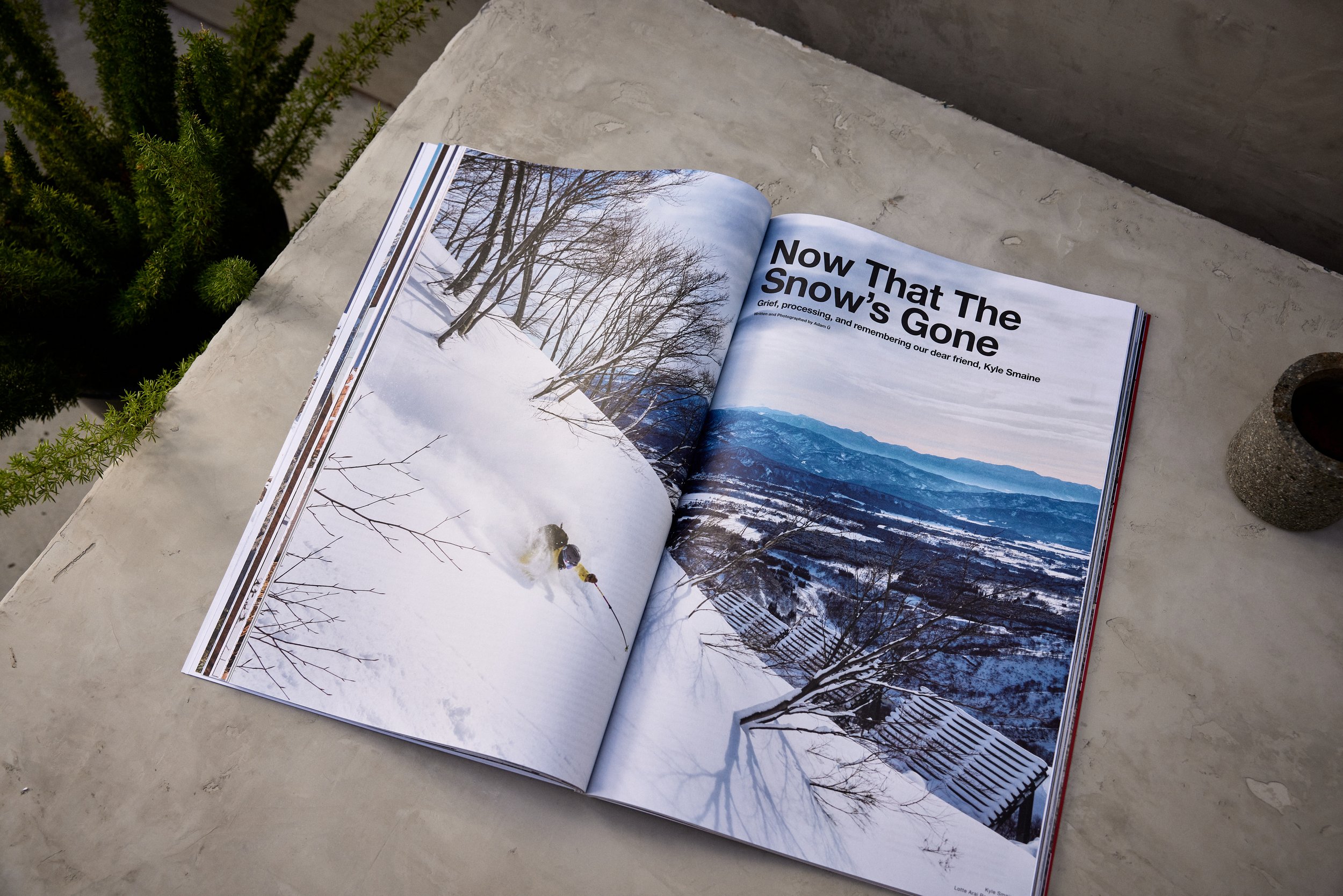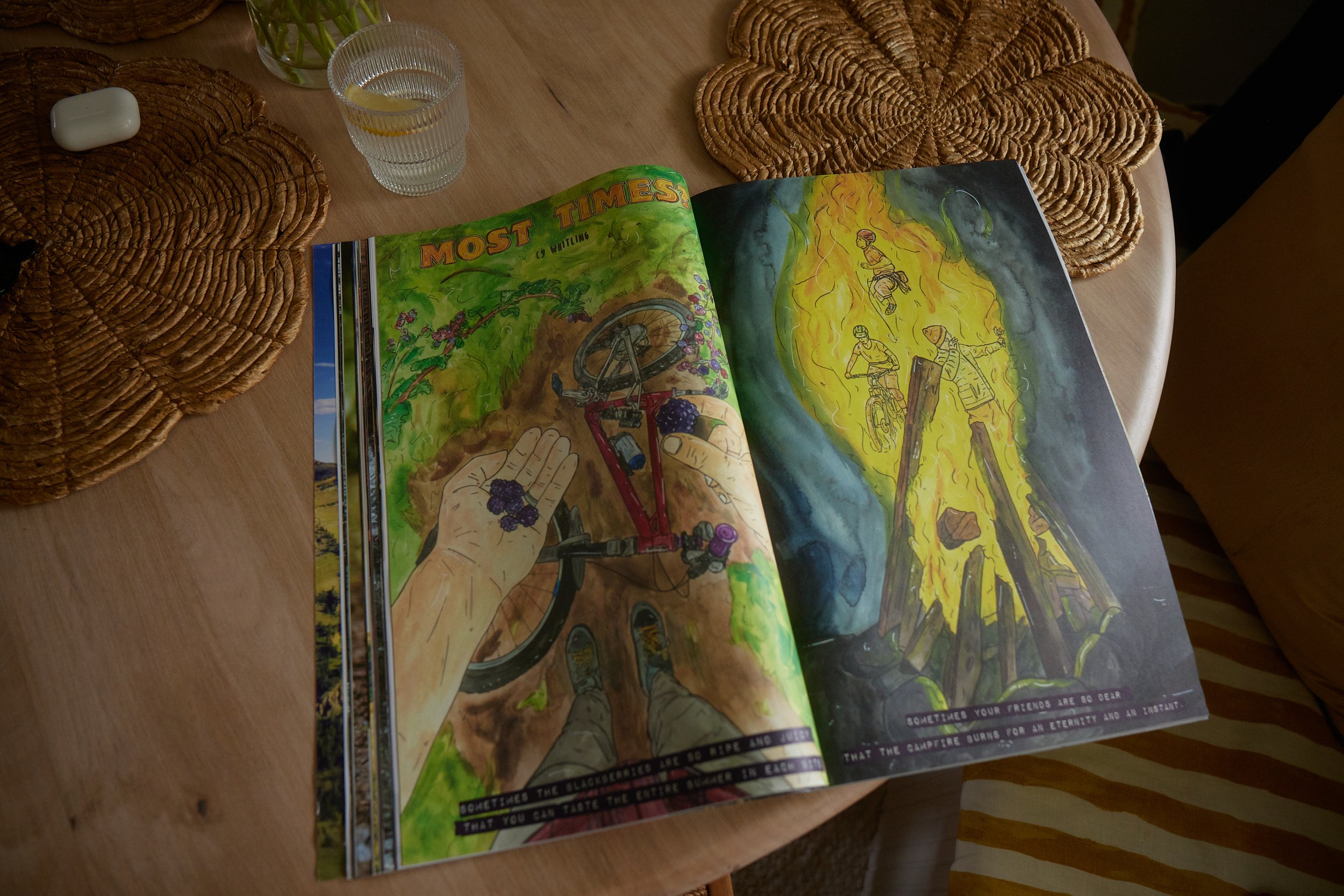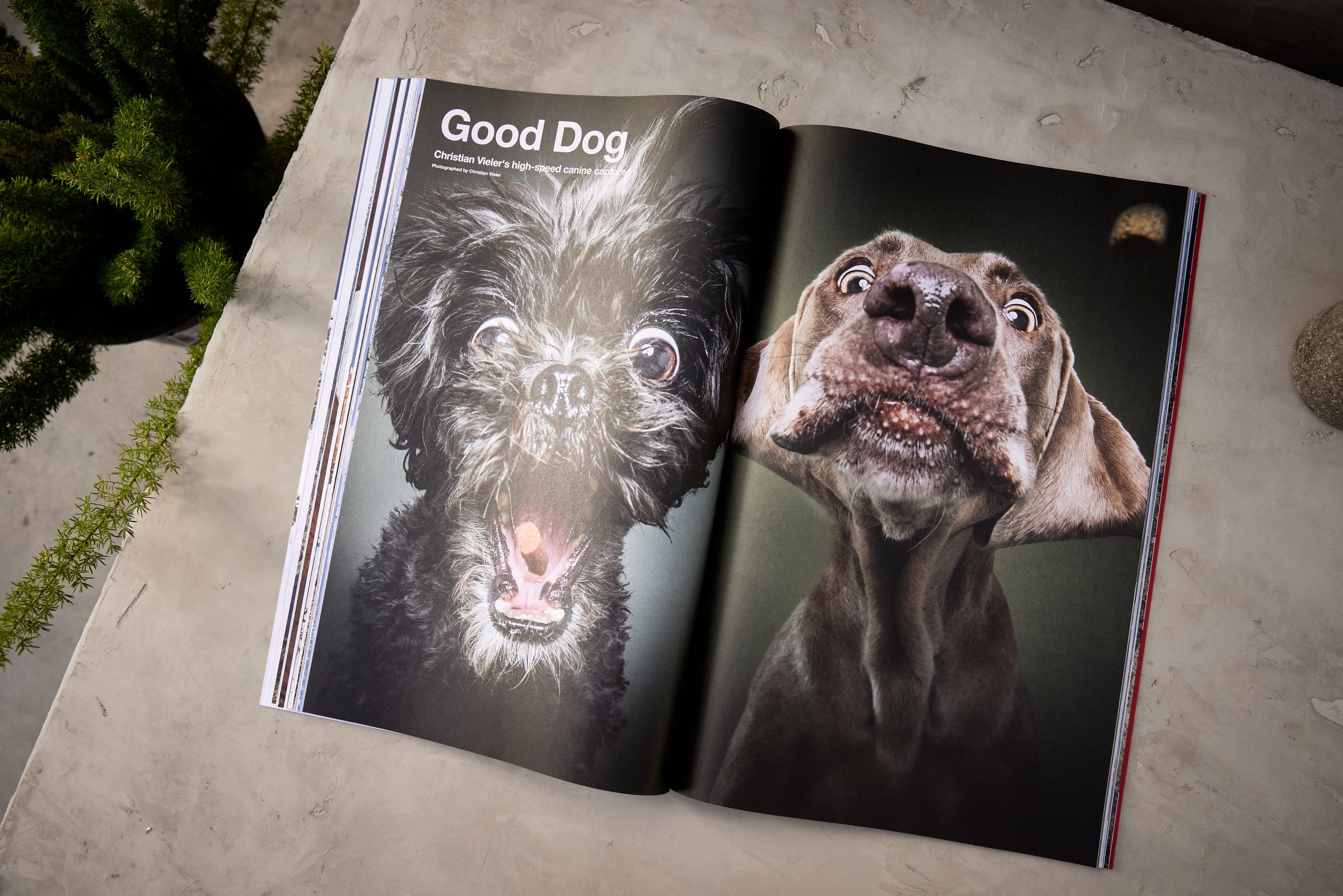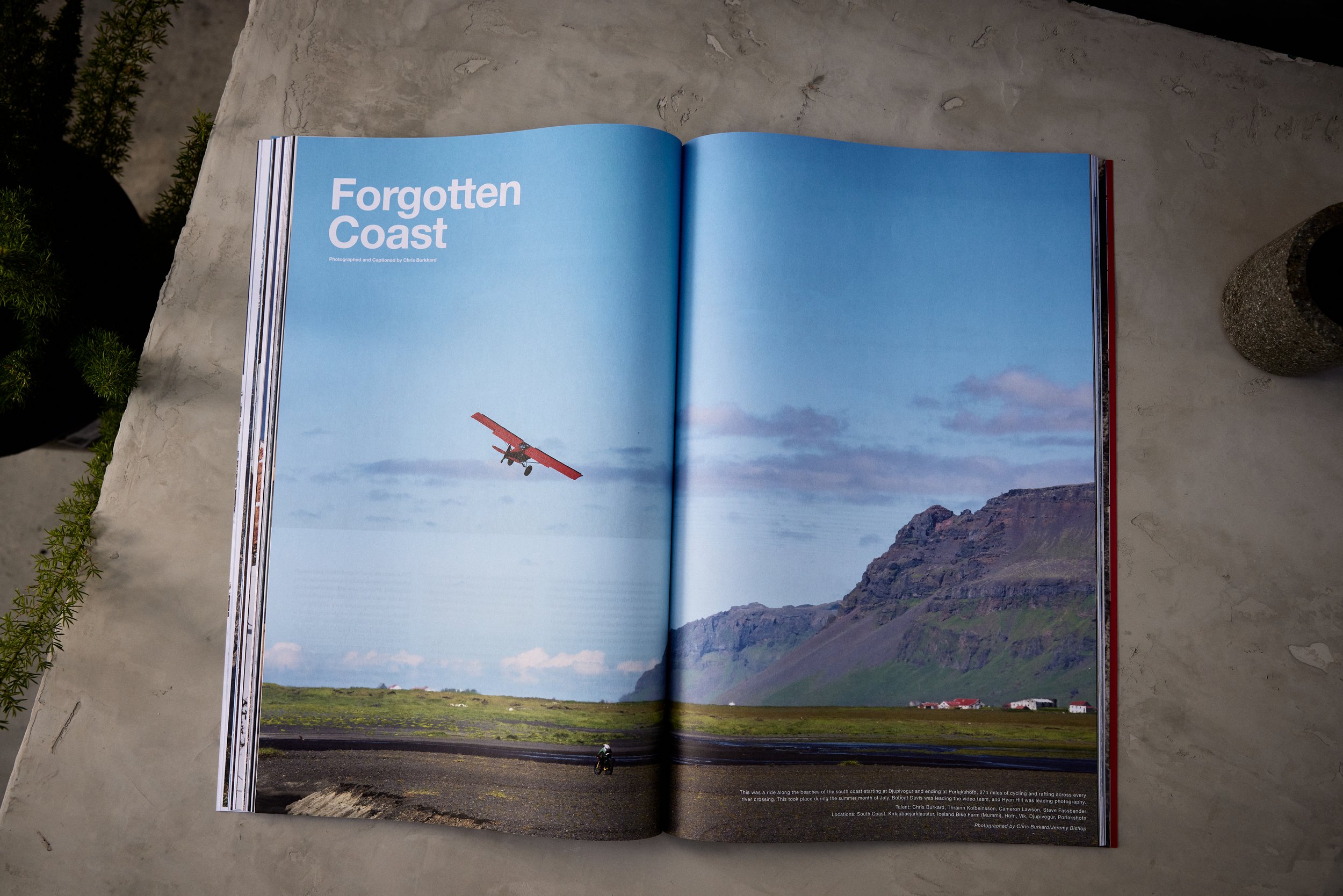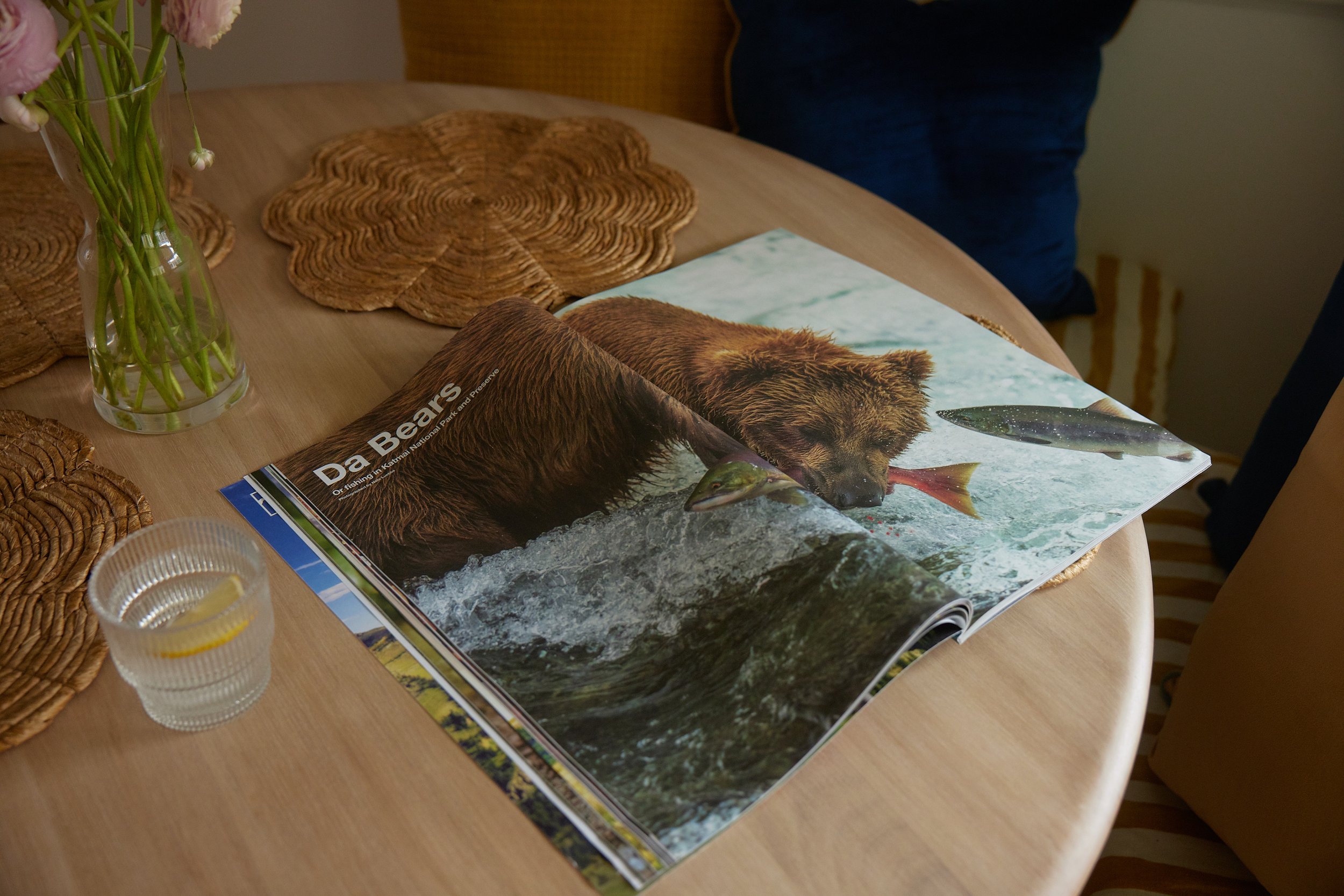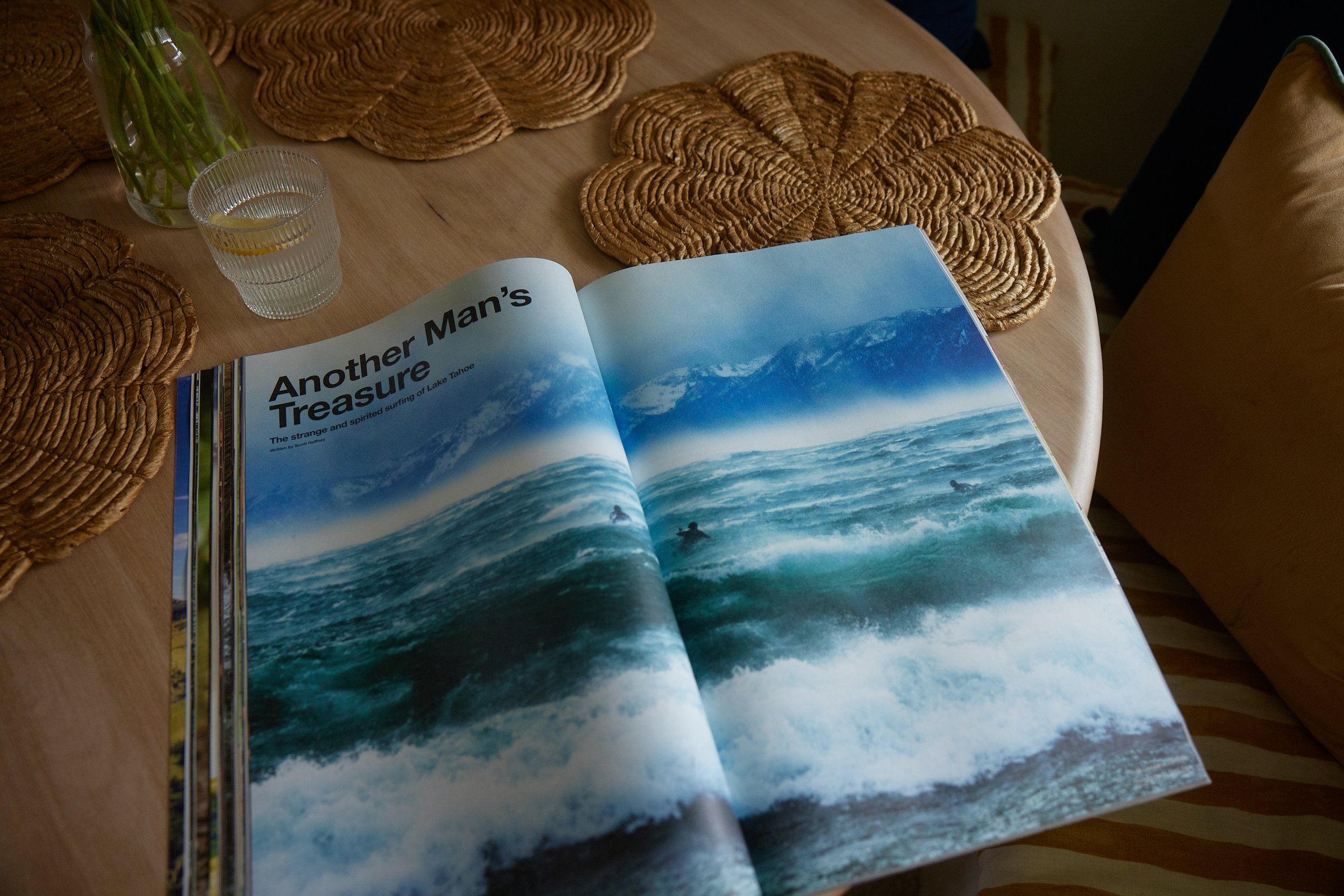Welcome to the Great Outdoors
A conversation with Mountain Gazette owner and editor Mike Rogge
—
THIS EPISODE IS MADE POSSIBLE BY OUR FRIENDS AT LANE PRESS
Mountain Gazette is one of those media … things … that only long-time fans really know about, with a long and colorful history. A kind of Village Voice of the outdoors, the first incarnation (1966) of the magazine was about mountains and for “mountain people”—a lifestyle magazine for those who weren’t interested in either coast, let alone cities, let alone New York.
Like many magazines, the Gazette succumbed to economic forces and shuttered. Twice. Until Mike Rogge, a journalist and film producer, and more important than that, an avid skier and outdoorsman, purchased the archives and the rights at a bar in Denver. The deal was drawn up on a napkin and consummated with a beer.
Mostly he bought it because it was there.
Rogge felt the media, specifically what he calls the outdoor media, was broken. Especially the advertising model. And he had grown tired of the arcane and opaque revenue streams of the digital world. So he decided to do his own thing. He rejected those models, and plowed into print.
And he went big. Literally. The result is a magazine that is a success in every sense of the word: aesthetically, editorially, and financially. It’s a black diamond in a magazine world that often feels like a series of bunny slopes.
But Mike Rogge and Mountain Gazette have proven something: you can have your mountain and ski it too.
The newest issue of Mountain Gazette
The infamous Mountain Gazette bill of sale.
Arjun Basu: So how did you get here? What’s your backstory and tell the story about how you bought the magazine—which is a great story in and of itself—but how did you get to that point?
Mike Rogge: Sure. So I was raised in upstate New York to two lovely parents who read to me quite a bit. I blame them for being here. I thank them for being here. And as a kid, my mom and I would go grocery shopping. We’re talking like when I was four or five, six years old. And I wanted to grab ski magazines off the rack. And my parents, we didn’t have a ton at the time. We came from pretty humble beginnings, but they had a policy in my family that books and magazines were something I could ask for when we were out.
And I like to think that’s how it started. My mom would pick up magazines for me and I would take them home and devour the articles. And, like all kids of the nineties, I would rip pages of Michael Jordan out of Sports Illustrated or Shane McConkie out of Freeze magazine. I would put them on my wall, wallpaper them, and then that became my vision board. Very early, early archaic version of Pinterest, I guess you could say, Arjun.
Arjun Basu: I think we all had vision boards like that growing up. My walls were just, I don’t think I had a single poster. I just had things that I cut out of whatever I found, that’s it.
Mike Rogge: Absolutely. When I look back, I was a pop culture kid. I didn’t think of anything as being “underground” or “mainstream.” If someone was performing in the Super Bowl halftime show, I wanted to buy their CD at Sam Goody afterwards. Or, if Michael Jordan had a great game, I wanted to rock Chicago Bulls hats or North Carolina hats, even though I’m this kid from upstate New York.
I was just talking with my friend Annie yesterday, who’s the editor of Adirondack Life. And what I realized is that the two magazines that were always in my house growing up were Adirondack Life and People magazine. And my mom has been a religious reader of People magazine since I can remember.
It may have been some of the first reading material I was ever given. And God help us. We all know they absolutely crushed the Princess Diana coverage. That was their wheelhouse.
Arjun Basu: Princess Diana was a flywheel for their content, yeah.
Mike Rogge: Oh man. If you’re wondering, Oh, aren’t magazines dead? And obviously we know that they’re not, but if you’re wondering why People magazine in particular isn’t dead, I think they’re still living off the interest of the money they made during the Princess Di and Charles divorce. And they just, they’re crushing it. So I grew up in upstate New York.
I grew up skiing, spending a lot of time outside. It’s part of the beauty of living in the Adirondacks is there’s 6 million acres that you can roam free in and really figure out who you are, and what you like, and what you like to do. And I spend a lot of time skiing and hiking and hanging out with my dogs, my friends, and playing baseball.
And at school—I was a little nineties kid—could just breeze my way through, except when it came to English. I was told by my teachers that my reading comprehension was pretty good and that I could write well.
And so much so that my senior year in my high school gave me three English classes to take because they wanted to see if I could hack it. And I loved it. I relished the idea of taking poetry, and Shakespeare, and Greek mythology as well as, like, a college-level English course. And so that was the beginning of where I am today.
Arjun Basu: So what was your first job?
Mike Rogge: Magazine, newspaper, or real job?
Arjun Basu: Let’s do this chronologically.
Mike Rogge: Sure. My dad owns and operates a 300-unit mobile home park in upstate New York. And so my first job was working on the back of a trash truck, and I was the recycling boy. That was my first job title and so what I would do is this is the early days of recycling in ‘96, ‘97, ‘98 that time frame, and I had to rip open trash bags and sort recycling and so I was really getting hands on with newspapers.
Arjun Basu: I want a t-shirt that says “recycling boy.”
Mike Rogge: That was it. I guess you could say that’s what I did with the Gazette, right?
Arjun Basu: What was your first magazine or media job?
Mike Rogge: Absolutely. So when I was 17 years old, I started a blog on a website called NewSchoolers.com. And I started writing about what I was seeing in New York and Vermont, New Hampshire, Maine, Massachusetts, even Connecticut to a certain extent. And I was seeing this new wave of free-skiing happening. And I noticed that the big ski media magazines were not writing about the Northeast.
And so I was. And I thought, I’m just going to write about what I see. And lo and behold, New Schoolers was acquired, and my free blog became something they were willing to pay for because it was getting enough traffic. They could sell ads off of it, and so I was in college. I was writing for a blog, and I thought, I have to get a summer internship.
Pretty archaic to say now, but my school wasn’t going to give me credit for having a blogging job. They wanted me to have a traditional media job. So I started working a shirt-and-tie all summer for the Glens Falls Chronicle, which is a weekly newspaper owned by Mark Frost and his family in Glens Falls, New York.
“I packed up my jeep and I drove across the country. I moved to San Clemente, California, to the heart of action sports in Southern California. And that was it.”
Arjun Basu: And it’s still around, right?
Mike Rogge: It’s still around. Yeah, it’s still there. There’s still a summer intern program. I’m a proud alumni of that paper. And they actually just went digital with a newsletter just two years ago. I’m a firm believer in print, but my gosh, I can’t believe that they made it this long with only going digital two years ago, but they’re doing great.
Arjun Basu: And so from there you transitioned to magazines.
Mike Rogge: Yeah. Out of college, I continued writing for the internet and was working for this company in Burlington called Ski the East. At that time, they were a community website. I was cranking out 250–300 stories a year. And we’re talking like long-form interviews with former Olympians, like snow reports, like product reviews, everything.
And to make a long story short, at a certain point, got to interview the editor of Powder and that became my opportunity to go work for Powder magazine, which in ski culture is known as the Bible of skiing.
Arjun Basu: Yeah, that’s the pinnacle.
Mike Rogge: When I got my interview, it felt like I was auditioning for Saturday Night Live. I was a comedian, something you could just tell your friends you did. And I never expected I’d get the job.
Arjun Basu: And you did.
Mike Rogge: I did. I did. I was in Burlington, Vermont, East Coast. And I found out pretty late at night. I called my dad, I think it was like 11:30. And I had this moment where I was like, I can remember I was on North Avenue in Burlington, Vermont. I pulled my car over and as the words were coming out of my mouth, I started crying because I just couldn’t believe that someone like me was about to have his whole life changed by going to work for this magazine I had picked up since I was five years old, six years old.
And I was only 23 years old at the time. I was one of the youngest editors ever hired at Powder. And I think it was just I was overwhelmed with emotion because I worked so hard at that point. You have to remember at 23 I’d already been a journalist for six years.
And then the craziest thing happened. A month later, I packed up my jeep and I drove across the country. I’d only been to California once for my job interview and I moved to San Clemente, California, to the heart of action sports in Southern California. And that was it. I got thrown into the ringer. It was an amazing journey.
Arjun Basu: So then you were writing the whole time, obviously. But then you got into the visual aspect of things, photography and video. And the videos of skiing is just—for people who don’t know, it’s just an enormous industry. And then you started this company Verb Cabin and how did you end up with Mountain Gazette?
Mike Rogge: So the long and short of it is that I spent three years at Powder. I felt like I steered a battleship, if you will, like just a big aircraft carrier, like in a new direction. I felt really positive about the work I had done there and I wanted to move on. So I left, I started Verb Cabin. And what I realized was that the way you would map out say the story arc of a feature was pretty similar to how you would do that for a short film. And I wanted to try it.
So I started directing, I started writing, I started producing. It’s really taught me to really strengthen the business muscle, I guess, of my brain. And from there I realized something was missing. I was having a lot of success. I’d gotten a film into the Banff Mountain Film Festival. We’ve won some awards. The contracts are pretty good. My now wife and I had bought a house in Lake Tahoe and I’m feeling really good, but there was something missing from me creatively, professionally. I was making work for other people. I wasn’t making work for myself anymore.
And so when I was up in Alaska at a bar called the Norwegian Rat, which is basically where every person that’s ever filmed or been on the show Deadliest Catch hangs out, I got a message from two of my friends that said, “Hey, we’ve been talking and we know you were looking for a magazine to buy.” And again, like a magazine to buy, it’s not like I had venture capital behind me or anything. I was looking for something that was dead and nobody wanted. They told me that was for sale.
And so I spent the $38 per hour that it costs to have internet in Alaska. And I called this man in West Virginia, Blake DeMasio. And Blake and I chatted and eight months later, we found ourselves in a bar in Denver talking about Mountain Gazette. I slipped Blake a check in an envelope, across the table. And I said, “Blake, you understand, I have to do this by myself. This is all I can afford. And I promise, if you let me do this I’ll restore the Gazette to what it’s supposed to be.” And he looked at the check. He smiled. I was nervous that he thought it was too low. He said, “If the check clears.” He goes, “Let’s have a beer to celebrate. We’ll put it in the bill of sale.”
Arjun Basu: Okay. So you bought Mountain Gazette. So let’s give people who aren’t aware of its history—because the history is quite amazing actually—just a little background on Mountain Gazette.
Mike Rogge: Of course, so Mountain Gazette was founded in 1966 in Colorado as Skiers Gazette. It was founded by a pretty brilliant editor named Mike Moore. Mike Moore was known for letting his writers go long, being a pretty light-handed editor. His objective—I’ve been told, I never got to meet him—was that he wanted the writer’s voice to come out and I really, that resonates with me.
I have never been a big fan of heavy-handed editing so that you “fit the voice of the magazine.” I like a lot of diverse voices. I feel a magazine at best is a mirror held to culture. And when it comes to outdoor sports, there is very much a mainstream outdoor sports and an underground, call it more “core” version of it.
And what I’ve always liked about Mountain Gazette is it was called the Village Voice of outdoor culture. I was always looking at—not so much the best and the brightest and the Olympians—it was looking more for the the dirtbags, the people sleeping on couches, the people waking up early to get powder turns, the people who are like sleeping in the back of their truck with their dogs or, at Camp Four where, say, Patagonia and Black Diamond were founded.
And I love that. And what was very cool to me was when I started digging through the archive. I learned that brands that we all know and love today, like The North Face, back when they were a little climbing shop in Berkeley, they were taking out some of their first ads in Mountain Gazette because they felt like it was the only magazine speaking to their culture.
And in a lot of respects, I think it was the first general-interest outdoor magazine. It changed its name to Mountain Gazette from Skiers Gazette in 1972. Then it shut down in 1979 because it was a regional magazine that was giving it away for free and was relying on ad revenue. These problems are the same, Arjun, they keep continuing again and again.
Arjun Basu: They keep continuing. And we’re going to get to that because you’ve said a few things about that. But some of the people that Mountain Gazette first published, Hunter S. Thompson—and I’d heard of it, but I hadn’t really, I’d never read it. And so just digging into it, I was amazed by what it was. And it was like a Village Voice, almost like a Creem of outdoor stuff. It was like all those people that were working in shops and skiing all day. That’s what they were reading. That was about them.
Mike Rogge: There’s always this phrase of “that was my magazine.” “That was my dad’s magazine.” “That was my grandfather’s magazine.”
What I found is that when I relaunched the mag in 2020 the first people to come through and subscribe were the people who had a personal, like almost family-style connection to the magazine, where they’re like—my uncle, people almost talk about like it’s Playboy, where they’re like, my uncle gave me a box of them and I had them under my bed.
And you never really knew what the Gazette was going to write about. And then, it did come back in 2000 under the leadership of John Fahey, who had his own legendary run with the Gazette until 2012. Peter Cray, Doug Schnitzbaum, these guys ran the Gazette for a certain period of time and brought a lot of modern day writers to the world into it. Brennan Leonard from Semi Rad, who’s got a great Instagram account, does a lot of visual medium stuff. He got his start in the Gazette.
And that was something that really enticed me too. I loved the idea of the legends, but I really loved the idea that amongst those legends were like, the rookies, if you will, that got their chance to come up and go right for other people, because someone saw them in the Gazette. And that is something that I’m still trying to carry on today.
Arjun Basu: So there’s a legacy, but you also obviously had to reinvent it, or try something that hadn’t been done before, while still carrying on what it was in many ways. So what did you want to do with it when you acquired it?
Mike Rogge: So what we’re doing today is the mission that we started almost four years ago, which is an 11 x 17 print format. The outdoors are huge by scale. It doesn’t make sense to consume photos by Jimmy Chin on an iPhone. Or even an iPad. They need to be big. They need to be printed in the highest DPI we can get from those guys.
Camera equipment has never been better. It is funny though, like a film camera—film looks really great in our pages as well, but I want big photos. And then along with that I never loved when I was at Powder, or the Ski Journal, the idea of a word count because these are epic journeys. No one’s doing the Iliad or the Odyssey anymore.
But at the same time, some of these journeys, whether they’re personal, or professional, or athletic—maybe all three, whatever—maybe the best stories take place over months, seasons, sometimes decades, sometimes lifetimes. Those stories deserve, maybe not a full book, but maybe they do deserve 10, 12, 14, 20,000 words. We have published a 28,000 word story in the Mountain Gazette. And what I love is that—it was written by Peter Cray—people just want more of it. They dive into it like a novella. And so I want that.
The other thing I wanted was mountain towns, especially today. They’ve always been challenging to live in. And one of the things that’s really cool is that pressure creates really great art. And the artists that are coming out of these mountain towns, they’re not in Brooklyn. They’re not in Los Angeles. They’re in Truckee. They’re in Jackson Hole. They’re in Coeur d’Alene, Idaho. And I wanted to give them a canvas so that you find this artist in Mountain Gazette.
And I’ll be honest, obviously we have a lot of people that sleep in the back of their trucks who read our magazine. We also have a lot of people that might have two Rivian trucks in their $40-million home in Aspen. Wouldn’t it be great to have those $40-million homeowners buying artwork from someone locally that could make them an original piece that becomes a statement piece for that artist. And so I wanted to give them a canvas and best of all, as I was like, “Man, we can just do things totally differently.”
Arjun, the worst part about working in a media company today is you have to do 50 things in order to do the one thing you want to do, which is write a great magazine piece. And I thought, What if we got rid of all that stuff, the travel guides, the gear reviews, the top 10 lists, the paid social, the advertorial, the events, the—frankly, no offense to this podcast—but like the podcast, like all the digital assets that you’re posting on Facebook, LinkedIn, all this stuff? What if you got rid of all that?
What if the objective of the company was simply to sell a magazine at a fair price, that pays contributors well, and creates a high-quality product specifically for the readers? I’m not the first person to think of The Surfers Journal who, in my opinion, has perfected this model for over 30-plus years. You can tell I’m getting passionate. This is all I wanted to do because I knew it would work.
And it’s not—I promise you—like it’s not arrogance, it’s just you go through these meat grinders of media companies and you see them fail because they’re overcapitalized. They’re over-leveraged. They have to provide a five, six, seven, 10x return. Media companies aren’t tech companies. And tech companies, frankly, aren’t very good media companies.
And you look at my resume, it’s, “Thank God the Mountain Gazette worked.” I worked for Powder and Powder shut down for three, four years. I worked for Vice Sports. And what is Vice now? Vice is basically what Verb Cabin was. They were making media, like, gun-for-hire. Which is sad because Vice magazine was exciting. And it made your heart move. It was scary. And I just thought, I want Mountain Gazette to be something that people love.
“Our readers rally for each other. They respond. Everybody on the internet is so angry, but I don’t see that in my corner of the world. ”
Arjun Basu: The other interesting thing you say is—and you mentioned this—nobody writes stories about the joy of going outside. And I had to really think about that, about how people live, and work, and play outside. And then I was like, I think that’s the first time someone has said that, like, that I can remember it. Like that you have a magazine about the joy of being outside. That’s cool.
Mike Rogge: It’s not to say that there aren’t problems in the world. Obviously in the outdoor space, we’re all very concerned about climate change. One of my favorite pieces that we’ve run about climate change was written by Sadie Stein, who is now with The New York Times Book Review.
And Sadie wrote about what it was like building snowmen in Central Park. You know, just very classic Norman Rockwell-like image, right? And how it hadn’t snowed in New York in two or three years. And it finally snowed and her son, who was really young at the time—there wasn’t enough snow to make a proper snowman. So he was just using like dirt and trash and kind of everything.
And she remembers thinking that this was a real personal, like in-your-face moment of just, Oh my gosh, like the climate truly is changing here. And thankfully New York got a little snow this last year, but I guess what happens, Arjun, is that like, when you have these 12–20 things you’re supposed to do, you forget why you got into this in the first place. And I did not get into skiing to become a climate activist and I certainly respect the people that are advocating for the climate.
But at the same time I’m a big believer that you have to know what you’re fighting for. We have a new story in our spring issue. And the opening story is a photo gallery by Chris Bennett, a photographer from Maine, who asked people: Why did you hike the Appalachian Trail? And it’s not as simple as that quote “because it’s there.” There’s a lot to it. People are complex.
And I think part of the joy of being alive is that five-sense emotion that you can have. And I think writers—not Chat GPT, not AI, not video content, not short-form, TikTok bullshit, whatever—I think writers, and photographers, and artists can be the real arbiters of what the human experience is like today. And I think a magazine is the message to tell people what’s going on in the world.
Arjun Basu: I think that also you said you made it big because nature is big. But I think, one, your covers, the visuals, like you said, they’re beautiful. You sell posters of the covers, all of them and everything is big. The stories are big. The photos are big. So the decision—did it start with, I really need to show this in the best possible light? Or did it start with Nature is Big? What was the thought in terms of going 11 x 17?
Mike Rogge: I’ll tell you one thing—and I’m very happy to share this—Victory Journal, out of Brooklyn, that’s produced by Doubleday and Cartwright. A good friend of mine who runs Ori magazine, Cade Krejciko, like before he had started Ori, he had actually interned for me at Powder. And then he wrote a piece for Victory Journal. And I saw skiing at that size and I thought, This is relatable. You can see the sparks coming off the edges of the ski hitting the concrete in this like street-skiing piece. And I remember thinking like I don’t know the last time I was able to count how many sparks were coming off the edge of a ski and I’ve been writing about this for 20 plus years. I was like, “This is it.” It was the size.
And then I started thinking about these talented writers that I knew that could close their eyes and bang out incredible copy, 400–500 words on a deadline, really quickly. And my thought was, What if I gave them six months, or a year, or 18 months to put out something they were really proud of?
And I tell everyone writing for Mountain Gazette, it’s very simple: You just have to put some of your life’s best work in it. And I’ll tell you, that can be a lot of pressure on some of our contributors. But what I always like to tell them is, “Hey, you’re here. You’ve got your assignment. You’ve got your word rate. You’ve got your deadline. The pressure’s off. You’ve already gotten the job. You don’t have to write for your job. Now you have to write for joy, or pleasure, or accomplishment, or whatever it might be.” And I think, Why did I want it to be big? Because it’s what I wanted. I wanted to read that stuff. I wanted to be inspired by our contributors. And I am. Deeply. Deeply.
Arjun Basu: It’s also, it’s not pricey for what it is, but if you tell someone a magazine is, what is it? $40? They’re like that’s pricey. But to be honest, it makes perfect sense to me. And I’m happy that it’s, it is what it is, because that means you’re creating it for the reader and not everyone else. That’s what broke everything. Not just magazines, it broke the media, broke TV. They still don’t know what they’re doing on TVs. I remember once having a talk with someone who was complaining that their subscription to Time was going up and it was such a small price. Like I looked at her and I said, “You’re still not paying for it. You’re a data point, but you’re not paying for the magazine itself. You’re not even paying for delivery.” How long can that last? And I just thought that was “magic” math. But what happens if the advertising goes away? And that’s what happened.
Mike Rogge: We have some great advertising partners. They’re very limited. We have about 10–12 in every issue. All of our ads are in the front and in the back of the magazine. I’m always proud that we have 120-plus pages of uninterrupted editorial. And I see a lot of independent magazines that are popping up and they’re doing the same thing.
And I’ll tell you, man, I don’t think of it as copying us or imitation is flattery. What I think is, That’s the way it should be. That shows respect for your reader. And I think that’s something going back to Glens Falls Chronicle. That was something that Mark used to say to me all the time was, “I don’t care what you know. I care what you learn.”
And the reader is the most important piece of this equation of who we make this for. We have to respect them. If we don’t respect the reader, they’ll never respect us. And if they don’t respect us, then advertisers won’t respect us. And if advertisers don’t respect us, we’re not a free weekly. That’s a very delicate balance.
What I like is that I don’t think of our readers as a number. I think of them as a community. I think about the fact that when one of our readers is in a little bit of trouble and has like a GoFundMe up, we can put that in our email and people who do not know this person will donate to a GoFundMe, thousands of dollars, Arjun, because that’s one of their people. That’s a Mountain Gazette subscriber.
And they feel good about that. I like to say we have the best readers in the world. I don’t know what their reading comprehension level is. I think some people do buy the magazine because the photos are pretty and they like it on their coffee table and that’s perfectly fine.
But what I really like about our readers is they rally for each other. They respond to our emails. They share opinions that are not just angry. Everybody on the internet is so angry, but I don’t see that in my corner of the world.
In the Mountain Gazette world, most people don’t have time for the internet because they’re out riding their bikes. They’re out cliff jumping into freshwater lakes. They’re out skinny dipping in high alpine lakes—which is a story we wrote a couple years ago. They’re fighting forest fires or they are bike messengers in New York City.
I think what’s cool is there’s this whole subset of people out there—and they like film, they like farm-to-table restaurants, they really like vinyl records—that really like physical media. And those are my kind of people, and those are the people we want at the Gazette. We don’t need any more subscribers. We don’t need any more advertisers. We’re perfectly content right where we are. And yet, here we are, still growing, four years in.
Arjun Basu: So what percentage of your readership are regular subscribers?
Mike Rogge: A hundred percent.
Arjun Basu: A hundred percent. Okay. And the team, your team is everywhere.
Mike Rogge: Yeah.
Arjun Basu: You have a distributed team, which is one of the ironies of being this gorgeous print magazine is that it doesn’t exist without the internet. Just as a former editor, how does the magazine come together with the team that’s all over the place?
Mike Rogge: Sure, so we have an art director in Glens Falls, New York. We have a copy editor in Phoenix, Arizona. We have a marketing person who splits their time between Utah and Maine. Our PR person is in Portland, Oregon. The community manager is in Tahoe with me. Writers are all over the world. Photographers are all over the world.
Simply, we use Dropbox and we use Google Drive. We use Google Docs. We use Google Sheets. We get 6,000 submissions per year. And we print less than 40 stories. So I have an editorial coordinator and two assistants that help me go through that stuff. We typically do not accept—well, one of the first stories that we got were “This Is What It’s Like to Be a Climbing Guide in COVID.”
And we just realized that we want our magazines to be timeless. And COVID was a point in time, but we didn’t want to put out our first issue and have it be all about COVID. Now we get a lot of, “Hey, my cousin’s really sick at skiing.” And respectfully, we hope your cousin is sick at skiing and he’s really good and he’s talented and he has a great career. She has a great career …
Arjun Basu: … But that’s not what we do.
Mike Rogge: That’s not what we do. There’s plenty of other places for that. And we wish them well, and we’ll “like” their Instagram video. So we go through those submissions. We have a lot of regular contributors, Ari Schneider probably being the most prolific. Ari’s working on his story for the fall and for next year for spring already. He’s already started reporting on his spring story for next year. I’m constantly communicating. That's just like what I do.
John and I use Adobe and John is sending me PDFs. I’m editing those PDFs on an iPad with an Apple Pencil, like a teacher. And marking it up with a red pen, even though it’s digital, just because we love print doesn’t mean that we’re Luddites. We certainly like to leverage technology, but the difference is we don’t rely on technology to make our money. We rely on technology to make the product that helps keep the lights on.
And so we’re always communicating. We’re texting. We don’t use Slack. We text, we email, we pick up the phone, we call each other. And big thing that we’re about at the Gazette is accountability. We really try not to make another member of our team wait for something. So if an article is due April 23rd, then we really would appreciate if it was uploaded April 22nd, but if it comes in on the 23rd, we hope it’s in the morning and we’re we all hold each other accountable. And I think that’s it. It’s just meeting deadlines and having respect for each other.
Arjun Basu: That sounds nice, I have to say. So more than one guest has said that what you’re doing feels like the future. And I don’t know if it’s the future, but it feels sustainable. Do we need to simplify for this to move forward as an industry?
Mike Rogge: I think so. I think so. I think when you look at other publications that are struggling right now, maybe they have too much venture capital. Maybe they have too broad of a scope. I do want to take a minute, I know that this podcast exists with Print Is Dead (Long Live Print!). And I think about Tina Brown. And for me, a big hero was David Granger. And I don’t remember what I was supposed to be wearing or buying when David was the editor of Esquire. What I remember is David being one of the first heterosexual men to start talking about what it meant to be a man in modern America.
Arjun Basu: … literally, that was the whole issue every year.
Mike Rogge: Yeah. And I remember him putting Mr. Rogers on the cover. Which was not a thing you were supposed to do. But of course, we look back now and—morally, ethically, everything—that was the perfect person to bring us back to our core and he put him on [the cover].
And so do we need to simplify things? Yes. I also think we need to start challenging what we all thought was taboo. Frankly, I find it funny that magazines are pretty boring and yet the biggest taboo is, like, advertorial, like letting an advertiser write a piece for you.
Yep, everybody’s okay with that. And our ad partners would never do that because they respect our readers too. And I really do think bringing it back to this medium where you get it twice a year. That’s it. It comes, it sits on your coffee table, and you can read it all.
But I think there’s something great about the fact that you cannot hold our magazine up. It takes two hands and you cannot have a phone. I suppose you could have an Apple Vision Pro on, but it feels like that product might be a dud for magazines in the same way that the iPad was supposed to be.
Dude, I use an iPad with magazines. But I use it to make a magazine, not to consume a magazine. I’ve always thought, Do not use these tech services. Use their products to make your stuff because it makes it pretty easy. I’m not worried about AI. I’m not worried about any of that stuff. Because AI, frankly, writes like a decent 10th grader, it’s not very good.
And I go back to this scene in Good Will Hunting where Robin Williams is telling Matt Damon on that bench in Boston like, “You could tell me all about our history, but you don’t know what the Sistine Chapel smells like, dude.” That’s what AI is. It’s like a hallucinogenic goofball thing that we’re all excited about. It’s the new cryptocurrency. And I certainly believe it’s going to have real tangible results and it’s going to make our world better. I really truly believe that.
But what it’s not going to do is make a magazine that has human emotion and heart in it. It can try, but we’re all going to see it’s just a robot pretending like there’s just nothing in the world, in my opinion, that could ever top the human condition, the human experience.
Arjun Basu: Would you ever create more than two issues a year? Or are you really comfortable with two?
Mike Rogge: We’re very happy with two. I like two. And I signed with a literary agent in January. And I’m working on my first book, and that’s definitely keeping me creative and thinking. I’m writing probably as much now as I was when I was 19. And that makes me feel really good because I got into this because I enjoy writing.
But as far as the Gazette goes, we’re doing two issues. We’re actually taking the month of May off from our newsletter, our digital newsletter, because we’re like, “Hey, the magazine’s out. We’re going to go outside and enjoy the magazine.” And I think, again, that’s just something we can do as a business that other people can't—taking that time off and getting refreshed and inspired in different locations and different places, different people. And come back in June, ready to keep going.
Arjun Basu: What are three magazines or media that you always recommend to people?
Mike Rogge: I’m going to tell you which ones I really enjoy now, because they’ve changed over the years. All my answers are long-winded and I apologize for that. It’s because my magazine is long-winded as well.
Okay. As a kid, we’re talking like in my teens, early twenties, it was David Granger’s Esquire, it was Powder magazine. And it was probably Freeze magazine, which was a short-lived alternative skiing magazine. That’s what I was most interested in.
But today, the magazines that I just absolutely adore the most are Michael Wiebe’s Summit Journal. I’m not even a climber and I just think that magazine is absolutely beautiful.
I love the Surfer’s Journal, by the Pesman family. They were the trailblazers, and I just think that they do a great job.
And then I’m really into Ori Magazine, which is run by Cade Krejciko, who I mentioned earlier. And Ori is a travel magazine written from the source. So a lot of the photographers and writers for these destinations are actually local to the area. And I find that to be a really interesting twist on a travel mag.
Arjun Basu: Mike, Thank you.
Mike Rogge: Thank you. This is the best. I love this podcast. And I like all the people that are making magazines. And I think if you want to make a magazine, stop sitting around. Start doing it!
Mike Rogge: Three Things
For more information, visit Mountain Gazette online, and on Instagram @mountaingazette.
More from Magazeum



